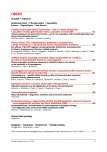Global assessment of haemostatic function - part II. Our experience with thrombin generation test using in thrombophilia patients
Authors:
A. Hluší 1; L. Slavík 1; J. Úlehlová 1; V. Krčová 1; J. Zapletalová 1; K. Indrák 1
Authors‘ workplace:
Hemato-onkologická klinika FN LF UP Olomouc, 2Ústav lékařské biofyziky, pracoviště biometrie
Lékařská fakulta UP Olomouc
1
Published in:
Transfuze Hematol. dnes,16, 2010, No. 3, p. 121-125.
Category:
Comprehensive Reports, Original Papers, Case Reports
Overview
Generally used haemostatic tests do not cover the complexity of clotting system. Estimation of the potential to generate thrombin, which is the central enzyme in the blood coagulation, may correlate with thrombophilic fenotype. In our study we used thrombin generation test to evaluate the parameters of thrombin generation curve in thrombophilic patients and healthy blood donors groups. We compare results in asymptomatic and symptomatic subgroups of thrombophilic mutation carriers and also an influence of acquired risk factor on thrombin generation is assessed. The results show higher generation of thrombin in carriers of thrombophilic mutation which is statistically significant.
Key words:
thrombophilia, thrombin generation test, acquired risk factors
Sources
1. Macfarlane R, Biggs R. A thrombin generation test; the application in haemophilia and thrombocytopenia. Journal of Clinical Pathology 1953; 6: 3–8.
2. Pitney WR, Dacie JV. A simple method of studying the generation of thrombin in recalcified plasma; application in the investigation of haemophilia. Journal of Clinical Pathology 1953; 6: 9–14.
3. Hemker HC, Beguin S. Thrombin generation in plasma: its assessment via the endogenous thrombin potential. Thrombosis and Haemostasis 1995; 74: 134-138.
4. Hemker HC, Giesen P, Al Dieri R, Regnault V, de Smedt E, Wagenvoord R, Lecompte T, Beguin S. Calibrated automated thrombin generation measurement in clotting plasma. Pathophysiology of Haemostasis and Thrombosis 2003; 33: 4-15.
5. Hemker HC, Willems GM, Beguin S. A computer assisted method to obtain the prothrombin activation velocity in whole plasma independent of thrombin decay processes. Thrombosis and Haemostasis 1986; 56: 9-17.
6. Hemker HC, Wielders S, Kessels H, Beguin S. Continuous registration of thrombin generation in plasma, its use for the determination of the thrombin potential. Thrombosis and Haemostasis 1993; 70: 617-624.
7. Hemker HC, Giesen PL, Ramjee M, Wagenvoord R, Beguin S. The thrombogram: monitoring thrombin generation in platelet-rich plasma. Thrombosis and Haemostasis 2000; 83: 589-591.
8. Hemker HC, et al. Thrombin generation, a function test of the haemostatic-thrombotic system. J Thromb Haemost 2006; 96: 553-561.
9. Váradi K, Turecek PL, Schwarz HP. Thrombin generation assay and other universal tests for monitoring haemophilia therapy. 2004; 10: s2, 17-21.
10. Hron G, Kollars M, Binder BR, Eichinger S, Kyrle P.A. Identification of patients at low risk for recurrent venous thromboembolism by measuring thrombin generation. JAMA: The Journal of the American Medical Association 2006; 296: 397-402.
11. Tripodi A, Legnani C, Chantarangkul V, Cosmi B, Palareti G, Mannucci PM. High thrombin generation measured in the presence of thrombomodulin is associated with an increased risk of recurrent venous thromboembolism. J Thromb Haemost 2008; 6: 1327–33.
12. Besser M, Baglin C, Luddington R, van Hylckama Vlieg A, Baglin T. High rate of unprovoked recurrent venous thrombosis is associated with high thrombin-generating potential in a prospective cohort study. J Thromb Haemost 2008; 6: 1720–5.
13. Devreese K, Wijns W, Combes I, et al. Thrombin generation in plasma of healthy adults and children: chromogenic versus fluorogenic thrombogram analysis. Thromb Haemost 2007; 98: 600-613.
14. Baglin T. The measurement and application of thrombin generation. Br J Haematol 2005; 130: 653-661.
15. Dargaud Y, Luddington R, Gray E, et al. Effect of standardization and normalization on imprecision of calibrated automated thrombography: an international multicentre study. Br J Haematol 2007; 139: 303-309.
16. Chandler WL, Roshal M. Optimization of Plasma Fluorogenic Thrombin-Generation Assays. 2009; 132(2):169-79.
Labels
Haematology Internal medicine Clinical oncologyArticle was published in
Transfusion and Haematology Today

2010 Issue 3
- Administration of aPCC as a Prevention of Bleeding After Major Cardiac Surgical Procedures
- The Importance of Hydration in Wound Healing
- Cost Effectiveness of FVIII Substitution Versus Non-Factor Therapy for Hemophilia A
- Vascular Disease in the Gradually Aging Population of Hemophiliacs: An Underestimated Problem?
- Prognostic Significance of Subclinical Joint Changes on MRI in Hemophilia
Most read in this issue
- Hairy cell leukemia – diagnostics, treatment and monoclonal antibodies
- Follicullar lymphoma and the significance of its tumour microenvironment
- Cytomegalovirus – specific cellular imunity: profile of immune function assesment provides clinically relevant answer
- Immunophenotypic characterization of acute leukemias of ambiguous lineage- new diagnostic entity of the revised WHO classification 2008
